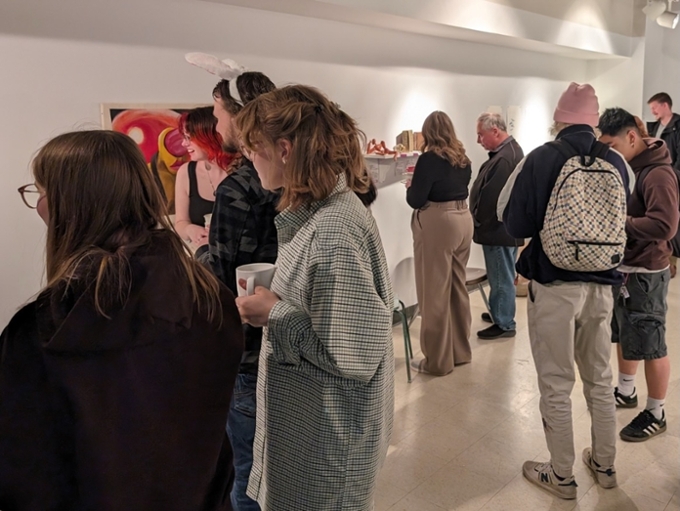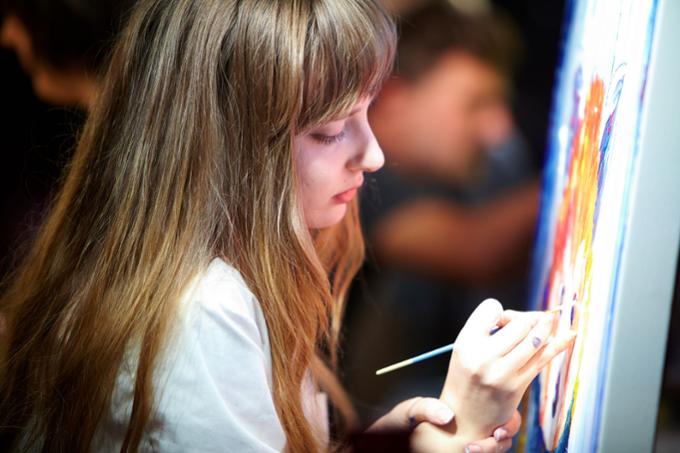
Visual Arts
Department Overview
The Department of Visual Arts lets students build a solid foundation in studio art practice and an in-depth study of art history. Our programs integrate the benefits of a liberal arts education within a program of artistic growth that provides students with finely honed critical and analytical abilities along with their development as a practicing artist.
Students may focus on sculpture, ceramics, painting, drawing, printmaking, photography, art history, cultures of display, or they can choose to practice across traditional mediums.
Small classes taught by experienced faculty who are professional artists, in bright, spacious, modern facilities ensure the best possible learning environment for Visual Arts students.
Visual Arts provides an environment and experiences enriched with cultural activities available through local art galleries, field trips to major art centres, and by visiting artists who share ideas and concepts of their art through workshops and lectures.


Visual Arts encourages individual artistic development by concentrating on studio practice. After a year and a half of work in a variety of studio areas, students will choose a concentration in: ceramics, drawing, intermedia, painting, photo-based media, printmaking, sculpture, or open studio which combines more than one of the areas.
Visual Arts Programs
Special Admission Requirements - Portfolio Review
Set up your appointment by contacting MAP.AdminHub@uregina.ca or calling 306-585-5572
What is a Portfolio Review?
A portfolio is a collection of art works in any medium (10 to 20 examples). A portfolio review is when you show your work to two or three professors and they let you know whether you are ready to be in the BFA or Certificate programs or if you need to take more studio courses and re-apply the following semester.
What Happens at the Portfolio Review?
The Portfolio Review takes 15 minutes.
For in-person reviews, arrive in the Visual Arts Department Office (Riddell Centre 247) 15 minutes ahead of your scheduled time. You will be directed to a nearby room where you can set up your work on tables or mount them on the wall. If you have digital work, please bring your laptop or tablet.
For online reviews, arrive at the Zoom link five minutes before your review. Be prepared to ‘share screen’ and talk to us about your work.
The Visual Arts professors will have read your letter and, if online, we will have already reviewed your work. We will greet you. If in-person, we will take a few minutes to look at your work. We will ask you questions about your art and your letter of introduction. We want to get to know you, your art, and what you would like to achieve in our program. We will tell you more about our course offerings and how you might make the most of the facilities and your time with us.
Some applicants may not have had access to quality art instruction and materials before coming to the University of Regina and worry they are not going to measure up. Bring what you have and let us tell you what we think. For example, if you only have pencil drawings and collages, but you have a lot of them, we might see work ethic, invention, ambition, and resourcefulness. We are not looking for fully-formed artists; we are looking for potential. Your letter of introduction is an opportunity to address any concerns or life challenges that you feel are relevant to your artistic development.
When the committee is done with questions, you will be invited to leave the room. After a few minutes of discussion, we will invite you back. We may tell you right away that you are accepted and that a formal email will follow, or we may need a little more time and will tell you that you will receive an email within two days.
What do you need to prepare for the Portfolio Review?
Once you have set up your review time and date with MAP Admin Hub team, you need to bring the following:
- Between ten and twenty of your recent art works: drawings, paintings (including digital), photo-based media, video, sculptures, ceramics, prints, comics, cos-play designs, or whatever creative things you have made and are proud of. The wider the range the better. We want to get to know you, what you can do, and what you want to do in our program. For in-person reviews, bring the actual artworks—though additional images on a USB stick is fine. If you want to show us work via website URL or file hosting service, or on a thumb drive let us know ahead of time [MAP.AdminHub@uregina.ca].
- An Image List with filename, title, date, size, and medium (required for online portfolio reviews only).
- A sketchbook(s), if you have one.
- Short letter of introduction. This is a 250-word statement telling us why you are interested in studying with us. Tell us who you are, why you love art. Write about some of the things you have made. If you have a career plan in mind, tell us about it. Please email the letter of introduction to the Visual Arts office [MAP.AdminHub@uregina.ca] three days before your review. Title the letter of introduction: lastname_firstname_letter.pdf or docx.
Be sure that your name is on your letter of introduction and image list.
Online Portfolio Reviews
We would like to meet you and see your art works in person. However, if you live out-of-town, or cannot join us for some other reason, online reviews are fine. The portfolio requirements are the same, though we have some special requirements.
Send up to twenty clear, well-lighted images of work in jpg format, max 1MB per file. Label them 01_lastname_firstname_title.jpg, 02_lastname_firstname_title.jpg, etc. For videos, please keep files to 2 minutes or less.
The portfolio must arrive in the Visual Arts office three days before your appointment, via Dropbox or Google Drive link. When using a file sharing services, include a password or have the files accessible to anyone with the link. Please do not submit images formatted in PowerPoint presentation files. Send the image list and letter of introduction as PDF or Microsoft Word documents.
A note on the Bachelor of Arts – Visual Arts Major
Applicants who do not gain admission after a portfolio review are encouraged to continue with or enter the BA-Visual Arts program and to reapply at a later date. The advantages of being a BA Visual Arts major: You get to choose your courses before non-majors. This is important when trying to get into very popular first and second year courses. If you are coming to the University of Regina for the first time, majors are eligible for an entrance scholarship.
The first year and a half of the BFA and BA-Visual Arts programs are the same. Studying in the BA-Visual Arts program enables students to build their portfolios as they take foundational studio courses and courses in Art History.
Compared to the BFA, the BA program has more electives and requires fewer studio courses. It works well if you are interested in doing double majors and minors such as the Arts Administration minor. This program is an excellent choice for students who want to study visual arts but are preparing for after-degrees in Education or other professional programs post degree.
The BA or the BFA – which is right for you?
The first year and a half of the BFA and BA-Visual Arts programs are the same. Studying in the BA-Visual Arts program enables students to build their portfolios as they take foundational studio courses and courses in Art History.
The BA program has more electives and requires fewer studio courses than the BFA. It works well if you are interested in doing double majors and minors such as the Arts Administration minor. This program is an excellent choice for students who want to study visual arts but are preparing for after-degrees in Education or other professional programs post degree.
The BFA requires fewer electives than the BA degree. It also allows students to take more studio courses at the Introductory and Senior levels, and requires more Art History Courses than the BA. The BFA provides courses in professional issues and culminates with a graduating group exhibition.
Applicants who do not gain admission after a portfolio review are encouraged to continue with the BA-Visual Arts program and to reapply at a later date. The advantages of being a Visual Arts major, whether BA or BFA: You get to choose your courses before non-majors. This is important when trying to get into very popular first and second year courses. If you are coming to the University of Regina for the first time, majors are eligible for an entrance scholarship.